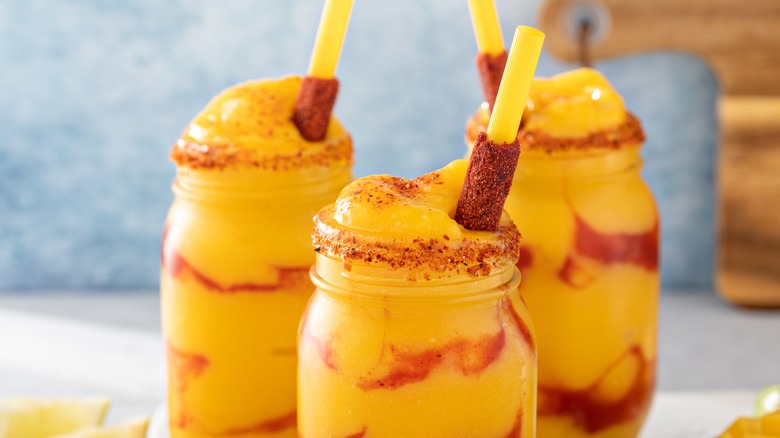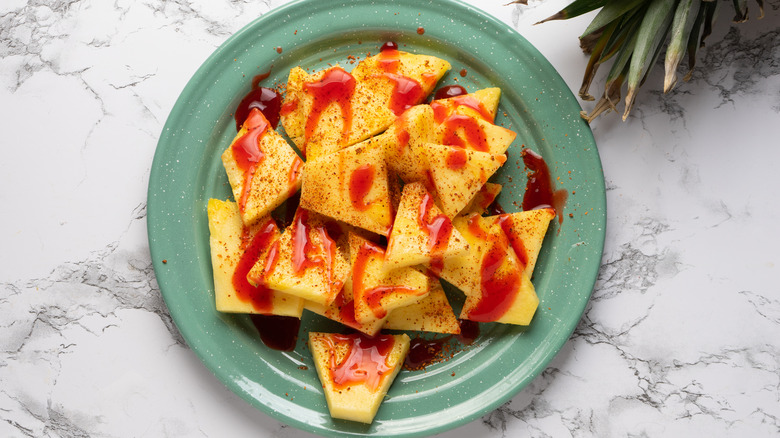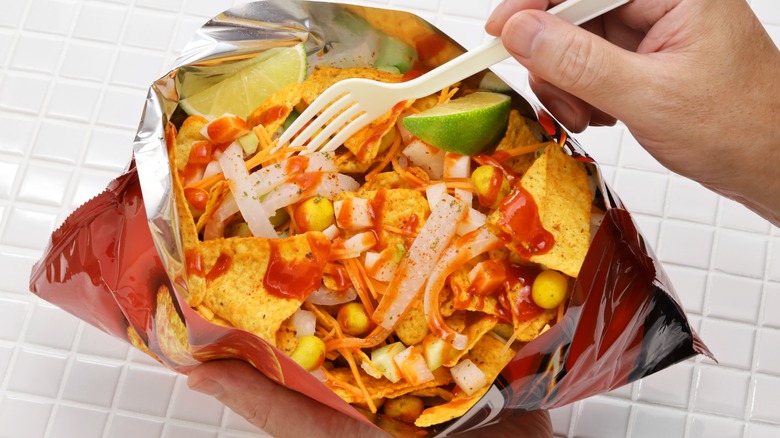What Is Chamoy And What Should You Drizzle It On?
Chamoy is a mouth-watering sauce or seasoning widely used in Mexico. If you don't have it in your life, you need it, especially as peak summer fruits, refreshing popsicles, poolside beers, and grilled meats take hold.
Chamoy is typically used in sauce form, but it can also be found dehydrated into a powder. Traditionally, apricot, plum, or mango are cured in salt. The liquid that is extracted from the fruits is used as the base of the chamoy, and the salty dried fruits, called saladitos, are eaten separately as a snack. Sugar, dried chilies, and lime are blended into the base, often with the addition of hibiscus and tamarind. Chamoy can also be made by boiling the dried fruit with the other ingredients until rehydrated and then puréed in the blender. There is an endless variety of chamoy blends with the addition of other types of dried fruit, different kinds of chilies, and varying levels of sugar.
As quintessential as chamoy is in Mexico, it has Asian roots. Spanish colonizers came with Asian products in tow, and Asians began to immigrate to Mexico beginning in the late 1500's. More than likely, chamoy is an off-shoot of either Japanese umeboshi or Cantonese see mui. Umeboshi are salted and dried plums that are then pickled in vinegar. See mui, also called crack seed, are salted and dried apricots that are eaten as-is or reconstituted in a sugar syrup. Notably, see mui is pronounced "see-moy."
Chamoy loves fruit, and fruit loves chamoy
Chamoy tastes similar to a sweet and sour sauce, but it is tangier, spicier, and more viscous. The heat and sweetness can vary depending on the intended use. Vendors selling ice-cold fruits such as mango, papaya, melons, pineapple, jicama, or even cucumber will dress large cups of fruit with lime juice, chamoy, and chamoy powder or Tajin. Tajin is the brand name of another spicy-sweet seasoning blend that contains salt, sugar, chili powder, and lime, whereas chamoy powder is the dehydrated version of the sauce and contains a lot more fruit.
Across Mexico, you can eat so many craveable fruit preparations. Whole apples covered in a thick chamoy are eaten like candy apples. Whole, fresh mangoes with a stick shoved through the seed are sliced to look like flowers. The petals catch the chamoy that's drizzled generously over the top. Jicaletas are round slices of jicama pierced with a stick so they look like popsicles and are then, of course, covered in chamoy.
You can also find frozen treats like paletas, or popsicles, made with combinations of fruit and chamoy (that can then be topped with more chamoy). Mangonadas are like sorbet sundaes with layers of fruit and chamoy and are topped with gummy candies and a tamarind and chamoy candy straw. Also called chamoyadas, these can be made with tamarind, passion fruit, watermelon, guava, or even chamoy sorbets.
What else can you drizzle (or douse) with chamoy?
Varieties of very sweet chamoy are eaten in candy form, whereas a more savory and spicy chamoy is delightful when used on grilled meat or vegetables. There are so many Mexican snacks that deliciously straddle the line between sweet and savory. Take Tostitlocos or Dorilocos, for example. A bag of Tostitos chips, often the salsa verde flavor, or Nacho Cheese Doritos are cut open and loaded with jicama, cucumber, cueritos, lime juice, Japanese-style peanuts, chili powder, and chamoy. Cueritos are a type of dried pork rind with a gelatinous texture, and Japanese-style peanuts have a thin, crunchy, coating. Variations can include different types of chips as the base. Add other vegetables, such as cabbage or carrots, or go over the top with esquites, shrimp cocktail, or ceviche.
Duros de harina, also called chicharrones, churros, or durritos, are a fried snack that resemble pork rinds but are made with flour. They come in many shapes — planks, pinwheels, squares, twists, and puffs — and can be served loaded and loco, or more simply with Valentina hot sauce or chamoy.
Chamoy makes a great rim for a michelada, a savory, tomato-based beverage similar to a Bloody Mary that uses beer instead of vodka. Of course, chamoy is also delicious along the rim of a margarita, paloma, mezcal cocktail, or a simple Mexican beer. However you choose to sample chamoy, your taste buds are in for a sweet and spicy treat.



